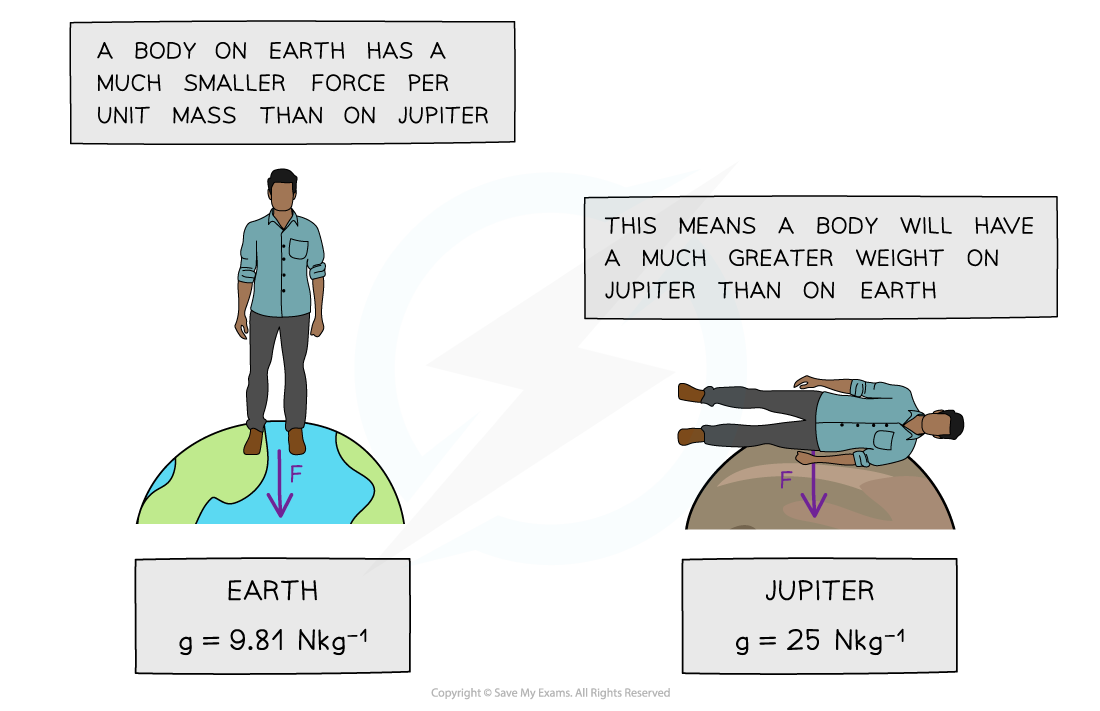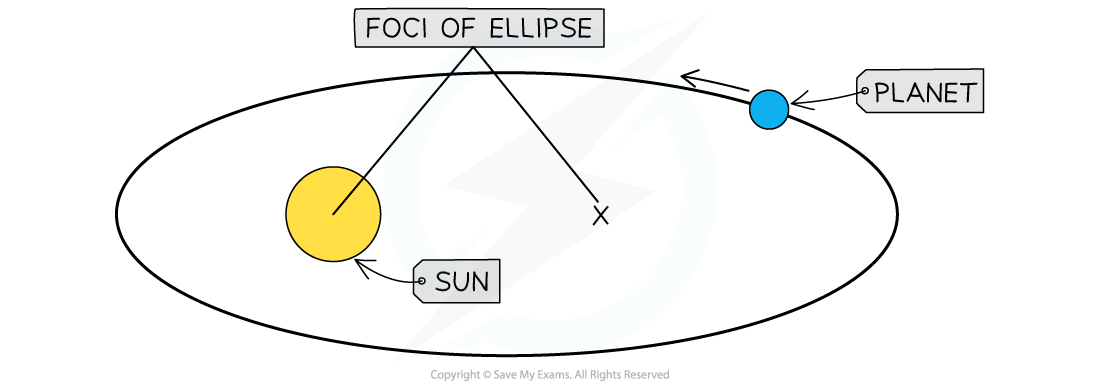Gravitational Effects on Orbits (Cambridge (CIE) O Level Physics): Revision Note
Exam code: 5054
Gravitational Field Strength & Planets
The strength of gravity on different planets affects an object's weight on that planet
Weight is defined as:
The force acting on an object due to gravitational attraction
Planets have strong gravitational fields
Hence, they attract nearby masses with a strong gravitational force
Because of weight:
Objects stay firmly on the ground
Objects will always fall to the ground
Satellites are kept in orbit
The Effect of Gravity on Earth

Objects are attracted towards the centre of the Earth due to its gravitational field strength
Both the weight of any body and the value of the gravitational field strength g differs between the surface of the Earth and the surface of other bodies in space, including the Moon because of the planet or moon's mass
The greater the mass of the planet then the greater its gravitational field strength
A higher gravitational field strength means a larger attractive force towards the centre of that planet or moon
g varies with the distance from a planet, but on the surface of the planet, it is roughly the same
The strength of the field around the planet decreases as the distance from the planet increases
However, the value of g on the surface varies dramatically for different planets and moons
The gravitational field strength (g) on the Earth is approximately 10 N/kg
The gravitational field strength on the surface of the Moon is less than on the Earth
This means it would be easier to lift a mass on the surface of the Moon than on the Earth
The gravitational field strength on the surface of the gas giants (eg. Jupiter and Saturn) is more than on the Earth
This means it would be harder to lift a mass on the gas giants than on the Earth
Values of Gravitational Field Strength

Value for g on the different objects in the Solar System
On such planets such as Jupiter, an object’s mass remains the same at all points in space
However, their weight will be a lot greater meaning for example, a human will be unable to fully stand up
Comparison of g on Earth & Jupiter

A person’s weight on Jupiter would be so large a human would be unable to fully stand up
Examiner Tips and Tricks
You do not need to remember the value of g on different planets for your exam, the value of g for Earth will be given in the exam question.
Gravitational Attraction of the Sun
There are many orbiting bodies in the Solar System which can be defined by the object that they orbit around
Orbiting Bodies in the Solar System
Orbiting body | What it orbits |
|---|---|
planet | the Sun |
the Moon | planet |
comet | the Sun |
asteroid | the Sun |
artificial satellite | any body in the Solar System (apart from the Sun) |
A smaller body or object will orbit a larger body
For example, a planet orbiting the Sun
In order to orbit a body such as a star or a planet, there has to be a force pulling the object towards that body
Gravity provides this force
Therefore, it is said that the force that keeps a planet in orbit around the Sun is the gravitational attraction of the Sun
The gravitational force exerted by the larger body on the orbiting object is always attractive
Therefore, the gravitational force always acts towards the centre of the larger body
Therefore, the force that keeps an object in orbit around the Sun is the gravitational attraction of the Sun and is always directed from the orbiting object to the centre of the Sun
The gravitational force will cause the body to move and maintain in a circular path
Orbital Motion of the Moon

Gravitational attraction causes the Moon to orbit around the Earth
Non-Circular Orbits
Orbits of planets, minor planets and comets are elliptical
An ellipse is just a 'squashed' circle
Planets, minor planets and comets have elliptical orbits
However, the Sun is not at the centre of an elliptical orbit
This is only the case when the orbit is approximately circular
An elliptical orbit

Planets and comets travel in elliptical orbits, but the Sun is not at the centre of these orbits
Examiner Tips and Tricks
You will not be asked to do any calculations with elliptical orbits. If you are asked to calculate the time period, orbital speed or radius of an orbit, it can be assumed that it is circular.
Sun's Gravitational Field & Distance
As the distance from the Sun increases:
The strength of the Sun's gravitational field on the planet decreases
The orbital speed of the planet decreases
To keep an object in a circular path, it must have a centripetal force
For planets orbiting the Sun, this force is gravity
Therefore, the strength of the Sun's gravitational field in the planet affects how much centripetal force is on the planet
This strength decreases the further away the planet is from the Sun, and the weaker the centripetal force
The centripetal force is proportional to the orbital speed
Therefore, the planets further away from the Sun have a smaller orbital speed
This also equates to a longer orbital duration
Orbital Speed & Distance

How the speed of a planet is affected by its distance from the Sun
This can be seen from data collected for a planet's orbital distance against their orbital speed
For example, Neptune travels much slower than Mercury
Orbital distance, period & speed of the planets in the Solar System
Planet | Orbital distance from Sun / million km | Orbital period | Orbital speed / km/s |
|---|---|---|---|
Mercury | 57.9 | 88 days | 47.9 |
Venus | 108.2 | 225 days | 35.0 |
Earth | 149.6 | 365 days | 29.8 |
Mars | 227.9 | 687 days | 24.1 |
Jupiter | 778.6 | 11.9 years | 13.1 |
Saturn | 1433.5 | 29.5 years | 9.7 |
Uranus | 2872.5 | 75 years | 6.8 |
Neptune | 4495.1 | 165 years | 5.4 |
Examiner Tips and Tricks
Be careful with your wording in this topic when talking about gravity. It is important to refer to the force of gravity as 'gravitational attraction', ' strength of the Sun's gravitational field' or 'the force due to gravity'. Avoid terms such as 'the Sun's gravity' or even more vague, 'the force from the Sun'.

Unlock more, it's free!
Did this page help you?